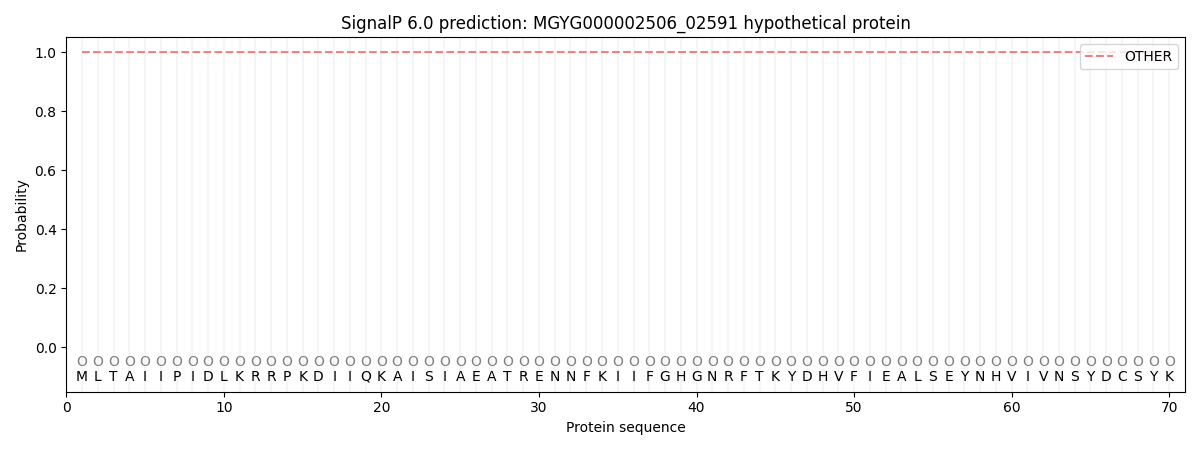You are browsing environment: HUMAN GUT
CAZyme Information: MGYG000002506_02591
You are here: Home > Sequence: MGYG000002506_02591
Basic Information |
Genomic context |
Full Sequence |
Enzyme annotations |
CAZy signature domains |
CDD domains |
CAZyme hits |
PDB hits |
Swiss-Prot hits |
SignalP and Lipop annotations |
TMHMM annotations
Basic Information help
| Species | Escherichia coli_D | |||||||||||
|---|---|---|---|---|---|---|---|---|---|---|---|---|
| Lineage | Bacteria; Proteobacteria; Gammaproteobacteria; Enterobacterales; Enterobacteriaceae; Escherichia; Escherichia coli_D | |||||||||||
| CAZyme ID | MGYG000002506_02591 | |||||||||||
| CAZy Family | GT2 | |||||||||||
| CAZyme Description | hypothetical protein | |||||||||||
| CAZyme Property |
|
|||||||||||
| Genome Property |
|
|||||||||||
| Gene Location | Start: 2632730; End: 2633722 Strand: - | |||||||||||
CAZyme Signature Domains help
| Family | Start | End | Evalue | family coverage |
|---|---|---|---|---|
| GT2 | 4 | 273 | 3.7e-20 | 0.9927536231884058 |
CDD Domains download full data without filtering help
| Cdd ID | Domain | E-Value | qStart | qEnd | sStart | sEnd | Domain Description |
|---|---|---|---|---|---|---|---|
| COG4092 | COG4092 | 2.77e-13 | 2 | 306 | 4 | 328 | Predicted glycosyltransferase involved in capsule biosynthesis [Cell wall/membrane/envelope biogenesis]. |
| pfam10111 | Glyco_tranf_2_2 | 2.57e-12 | 3 | 273 | 1 | 276 | Glycosyltransferase like family 2. Members of this family of prokaryotic proteins include putative glucosyltransferase, which are involved in bacterial capsule biosynthesis. |
| cd06420 | GT2_Chondriotin_Pol_N | 2.66e-06 | 78 | 205 | 71 | 170 | N-terminal domain of Chondroitin polymerase functions as a GalNAc transferase. Chondroitin polymerase is a two domain, bi-functional protein. The N-terminal domain functions as a GalNAc transferase. The bacterial chondroitin polymerase catalyzes elongation of the chondroitin chain by alternatively transferring the GlcUA and GalNAc moiety from UDP-GlcUA and UDP-GalNAc to the non-reducing ends of the chondroitin chain. The enzyme consists of N-terminal and C-terminal domains in which the two active sites catalyze the addition of GalNAc and GlcUA, respectively. Chondroitin chains range from 40 to over 100 repeating units of the disaccharide. Sulfated chondroitins are involved in the regulation of various biological functions such as central nervous system development, wound repair, infection, growth factor signaling, and morphogenesis, in addition to its conventional structural roles. In Caenorhabditis elegans, chondroitin is an essential factor for the worm to undergo cytokinesis and cell division. Chondroitin is synthesized as proteoglycans, sulfated and secreted to the cell surface or extracellular matrix. |
| pfam02709 | Glyco_transf_7C | 1.21e-04 | 165 | 202 | 23 | 60 | N-terminal domain of galactosyltransferase. This is the N-terminal domain of a family of galactosyltransferases from a wide range of Metazoa with three related galactosyltransferases activities, all three of which are possessed by one sequence in some cases. EC:2.4.1.90, N-acetyllactosamine synthase; EC:2.4.1.38, Beta-N-acetylglucosaminyl-glycopeptide beta-1,4- galactosyltransferase; and EC:2.4.1.22 Lactose synthase. Note that N-acetyllactosamine synthase is a component of Lactose synthase along with alpha-lactalbumin, in the absence of alpha-lactalbumin EC:2.4.1.90 is the catalyzed reaction. |
CAZyme Hits help
| Hit ID | E-Value | Query Start | Query End | Hit Start | Hit End |
|---|---|---|---|---|---|
| QJF83032.1 | 3.09e-244 | 1 | 330 | 1 | 330 |
| AYZ39141.1 | 1.79e-243 | 1 | 330 | 1 | 330 |
| ATB91626.1 | 1.79e-243 | 1 | 330 | 1 | 330 |
| AOM71446.1 | 1.79e-243 | 1 | 330 | 1 | 330 |
| QJB51035.1 | 1.79e-243 | 1 | 330 | 1 | 330 |
Swiss-Prot Hits help
SignalP and Lipop Annotations help
This protein is predicted as OTHER

| Other | SP_Sec_SPI | LIPO_Sec_SPII | TAT_Tat_SPI | TATLIP_Sec_SPII | PILIN_Sec_SPIII |
|---|---|---|---|---|---|
| 1.000043 | 0.000000 | 0.000000 | 0.000000 | 0.000000 | 0.000000 |
